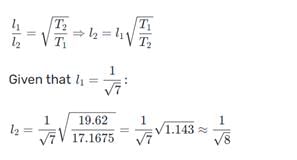JEE Exam > JEE Tests > Daily Test for JEE Preparation > Test: Waves-Speed of a Traveling Wave (16 Oct) - JEE MCQ
Test: Waves-Speed of a Traveling Wave (16 Oct) - JEE MCQ
Test Description
10 Questions MCQ Test Daily Test for JEE Preparation - Test: Waves-Speed of a Traveling Wave (16 Oct)
Test: Waves-Speed of a Traveling Wave (16 Oct) for JEE 2025 is part of Daily Test for JEE Preparation preparation. The Test: Waves-Speed of a Traveling Wave (16 Oct) questions and answers have been
prepared according to the JEE exam syllabus.The Test: Waves-Speed of a Traveling Wave (16 Oct) MCQs are made for JEE 2025 Exam. Find important
definitions, questions, notes, meanings, examples, exercises, MCQs and online tests for Test: Waves-Speed of a Traveling Wave (16 Oct) below.
Solutions of Test: Waves-Speed of a Traveling Wave (16 Oct) questions in English are available as part of our Daily Test for JEE Preparation for JEE & Test: Waves-Speed of a Traveling Wave (16 Oct) solutions in
Hindi for Daily Test for JEE Preparation course. Download more important topics, notes, lectures and mock
test series for JEE Exam by signing up for free. Attempt Test: Waves-Speed of a Traveling Wave (16 Oct) | 10 questions in 20 minutes | Mock test for JEE preparation | Free important questions MCQ to study Daily Test for JEE Preparation for JEE Exam | Download free PDF with solutions
Test: Waves-Speed of a Traveling Wave (16 Oct) - Question 1
What does 'n21' represent in the context of Snell's law of refraction?
Detailed Solution for Test: Waves-Speed of a Traveling Wave (16 Oct) - Question 1
Test: Waves-Speed of a Traveling Wave (16 Oct) - Question 2
What is the condition for the reflected wavefront in reflection to be built up from secondary wavelets?
Detailed Solution for Test: Waves-Speed of a Traveling Wave (16 Oct) - Question 2
Test: Waves-Speed of a Traveling Wave (16 Oct) - Question 3
In Malus Law, what does 'I' represent?
Detailed Solution for Test: Waves-Speed of a Traveling Wave (16 Oct) - Question 3
Test: Waves-Speed of a Traveling Wave (16 Oct) - Question 4
What is the name given to the angle at which light is polarized when it reflects from a transparent surface?
Detailed Solution for Test: Waves-Speed of a Traveling Wave (16 Oct) - Question 4
Test: Waves-Speed of a Traveling Wave (16 Oct) - Question 5
What is the name given to light that has vibrations of the electric field vector in only one direction perpendicular to the direction of propagation?
Detailed Solution for Test: Waves-Speed of a Traveling Wave (16 Oct) - Question 5
Test: Waves-Speed of a Traveling Wave (16 Oct) - Question 6
What happens to the width of the central maximum in a diffraction pattern when the width of the single slit is decreased?
Detailed Solution for Test: Waves-Speed of a Traveling Wave (16 Oct) - Question 6
Test: Waves-Speed of a Traveling Wave (16 Oct) - Question 7
What does the refractive index 'n2' represent in the context of absolute refractive index?
Detailed Solution for Test: Waves-Speed of a Traveling Wave (16 Oct) - Question 7
Test: Waves-Speed of a Traveling Wave (16 Oct) - Question 8
An iron load of  is suspended in air from the free end of a sonometer wire of length
is suspended in air from the free end of a sonometer wire of length  . A tuning fork of frequency
. A tuning fork of frequency  , is in resonance with
, is in resonance with  times the length of the sonometer wire. If the load is immensed in water, the length of the wire in metre that will be in resonance with the same tuning fork is (Specific gravity of iron = 8)
times the length of the sonometer wire. If the load is immensed in water, the length of the wire in metre that will be in resonance with the same tuning fork is (Specific gravity of iron = 8)
Detailed Solution for Test: Waves-Speed of a Traveling Wave (16 Oct) - Question 8
Test: Waves-Speed of a Traveling Wave (16 Oct) - Question 9
The frequency of a tuning fork is  and velocity of sound in air is
and velocity of sound in air is  . Find how far the sound has traversed while fork completes 36 vibrations?
. Find how far the sound has traversed while fork completes 36 vibrations?
Detailed Solution for Test: Waves-Speed of a Traveling Wave (16 Oct) - Question 9
Test: Waves-Speed of a Traveling Wave (16 Oct) - Question 10
A source of the sound of frequency  is placed inside water. The speed of sound in water is
is placed inside water. The speed of sound in water is  and in the air, it is
and in the air, it is  The frequency of sound recorded by an observer who is standing in the air is
The frequency of sound recorded by an observer who is standing in the air is
 is placed inside water. The speed of sound in water is
is placed inside water. The speed of sound in water is  and in the air, it is
and in the air, it is  The frequency of sound recorded by an observer who is standing in the air is
The frequency of sound recorded by an observer who is standing in the air is
Detailed Solution for Test: Waves-Speed of a Traveling Wave (16 Oct) - Question 10
|
360 tests
|
Information about Test: Waves-Speed of a Traveling Wave (16 Oct) Page
In this test you can find the Exam questions for Test: Waves-Speed of a Traveling Wave (16 Oct) solved & explained in the simplest way possible.
Besides giving Questions and answers for Test: Waves-Speed of a Traveling Wave (16 Oct), EduRev gives you an ample number of Online tests for practice








 v.t
v.t 


















